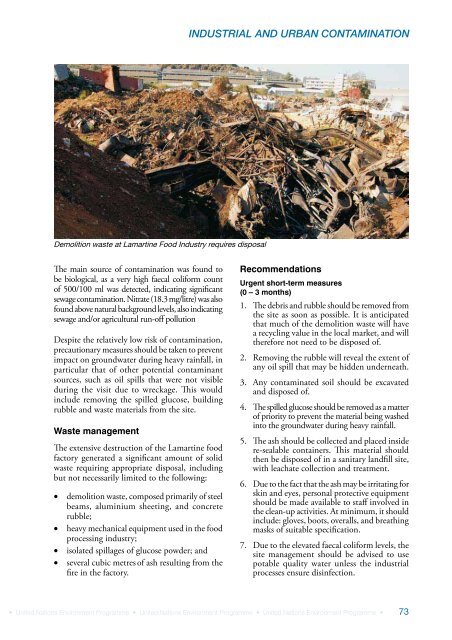Lebanon Post-Conflict Environmental Assessment - UNEP
Lebanon Post-Conflict Environmental Assessment - UNEP
Lebanon Post-Conflict Environmental Assessment - UNEP
Create successful ePaper yourself
Turn your PDF publications into a flip-book with our unique Google optimized e-Paper software.
INDUSTRIAL AND URBAN CONTAMINATIONDemolition waste at Lamartine Food Industry requires disposalThe main source of contamination was found tobe biological, as a very high faecal coliform countof 500/100 ml was detected, indicating significantsewage contamination. Nitrate (18.3 mg/litre) was alsofound above natural background levels, also indicatingsewage and/or agricultural run-off pollutionDespite the relatively low risk of contamination,precautionary measures should be taken to preventimpact on groundwater during heavy rainfall, inparticular that of other potential contaminantsources, such as oil spills that were not visibleduring the visit due to wreckage. This wouldinclude removing the spilled glucose, buildingrubble and waste materials from the site.Waste managementThe extensive destruction of the Lamartine foodfactory generated a significant amount of solidwaste requiring appropriate disposal, includingbut not necessarily limited to the following:demolition waste, composed primarily of steelbeams, aluminium sheeting, and concreterubble;heavy mechanical equipment used in the foodprocessing industry;isolated spillages of glucose powder; andseveral cubic metres of ash resulting from thefire in the factory.RecommendationsUrgent short-term measures(0 – 3 months)1. The debris and rubble should be removed fromthe site as soon as possible. It is anticipatedthat much of the demolition waste will havea recycling value in the local market, and willtherefore not need to be disposed of.2. Removing the rubble will reveal the extent ofany oil spill that may be hidden underneath.3. Any contaminated soil should be excavatedand disposed of.4. The spilled glucose should be removed as a matterof priority to prevent the material being washedinto the groundwater during heavy rainfall.5. The ash should be collected and placed insidere-sealable containers. This material shouldthen be disposed of in a sanitary landfill site,with leachate collection and treatment.6. Due to the fact that the ash may be irritating forskin and eyes, personal protective equipmentshould be made available to staff involved inthe clean-up activities. At minimum, it shouldinclude: gloves, boots, overalls, and breathingmasks of suitable specification.7. Due to the elevated faecal coliform levels, thesite management should be advised to usepotable quality water unless the industrialprocesses ensure disinfection.• United Nations Environment Programme • United Nations Environment Programme • United Nations Environment Programme •73
















